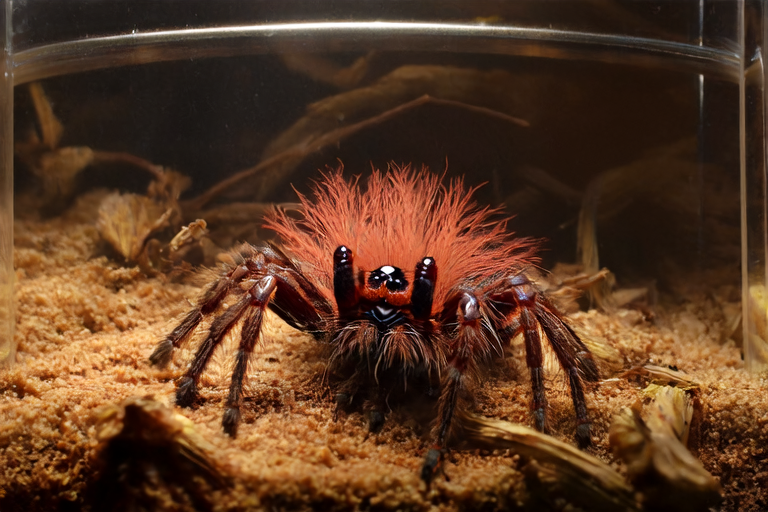Top 5 Care Tips for Chilean Rose Tarantulas
The Chilean Rose tarantula (Grammostola rosea) is one of the most popular species among tarantula enthusiasts due to its docile nature and ease of care. However, providing optimal care requires understanding their basic needs, feeding habits, habitat setup, interaction practices, and health maintenance. This article will cover these aspects in detail to help you become a responsible keeper of this fascinating arachnid.
Basic Needs: Temperature, Humidity, and Habitat
Chilean Rose tarantulas thrive in environments that mimic their natural habitats in South America. They prefer temperatures between 75°F and 85°F (24°C to 29°C), with humidity levels around 60% to 70%. To achieve this, keepers should use a thermometer and hygrometer to monitor conditions within the enclosure. A heat mat or ceramic heater can be used to maintain appropriate temperatures, while misting or using a humidifier can help regulate humidity.
Their enclosure should provide enough space for them to move freely without feeling cramped. For an adult Chilean Rose, a tank measuring at least 10 gallons (38 liters) is recommended. The substrate should be at least four inches deep, made from coconut fiber or bark chips, which allows burrowing and maintains proper moisture levels. Additionally, include hiding spots like cork bark or half logs where they can retreat when stressed or during molting periods.
Feeding Recommendations
Chilean Rose tarantulas are carnivorous and require a diet rich in protein. Their primary food source consists of crickets, but they may also consume other insects such as mealworms, wax moths, and small roaches. It’s important not to overfeed; typically, one appropriately sized prey item per week is sufficient for adults. Juveniles may need more frequent feedings—every few days depending on size and growth rate.
To ensure proper nutrition, gut loading the feeder insects before offering them to your tarantula is crucial. Gut loading involves feeding nutritious foods to the prey items themselves prior to being fed to the spider. This process enhances the nutritional value of the meal for your pet. Avoid feeding wild-caught insects, as they might carry parasites or toxins harmful to your tarantula.
Setting Up and Maintaining Their Living Space
Proper setup of the living space is essential for maintaining the health and well-being of your Chilean Rose tarantula. Start by selecting a suitable enclosure with adequate ventilation. Glass tanks with screen tops work well because they allow air circulation while preventing escapes. Ensure that any decorations or accessories added do not pose choking hazards or sharp edges that could injure your pet.
Regular cleaning of the enclosure is necessary to prevent buildup of waste products and mold. Remove uneaten prey and droppings promptly after each feeding session. Perform thorough cleanings every two weeks, removing all substrate and disinfecting surfaces before replacing fresh materials. Always use non-toxic cleaning agents specifically designed for reptile enclosures.
Best Practices for Interaction
Handling Chilean Rose tarantulas should be done cautiously to avoid causing stress or injury. These spiders are generally calm but can bite if provoked or mishandled. When handling, gently scoop up the spider using both hands, supporting its body from underneath rather than grabbing it by legs or abdomen.
Avoid excessive handling sessions as prolonged exposure outside their enclosure can cause undue stress. Limit interactions to brief periods, allowing plenty of time for the spider to rest undisturbed. If you notice signs of distress such as rapid leg movements or retraction into their burrow, return the spider immediately to its home environment.
Common Health Issues and Preventive Measures
Like any animal, Chilean Rose tarantulas can face certain health issues. Common problems include mite infestations, dehydration, and improper shedding. Mites can be introduced through contaminated substrates or live prey, leading to irritation and potential infections. Regularly inspect your spider for unusual spots on its body and treat suspected cases promptly using safe miticides formulated for tarantulas.
Dehydration can occur if humidity levels drop too low, causing difficulty in producing silk for webs or burrows. Monitor humidity closely and adjust as needed. Improper shedding, known as “dying moult,” happens when a tarantula cannot fully extricate itself from its old exoskeleton. In such situations, refrain from interfering unless absolutely necessary; sometimes gentle misting helps soften the remaining skin, aiding completion of the process.
In conclusion, caring for Chilean Rose tarantulas involves meeting their specific environmental requirements, providing balanced diets, maintaining clean habitats, practicing safe handling techniques, and addressing potential health concerns proactively. By following these guidelines, you can ensure that your pet enjoys a long and healthy life in captivity.
